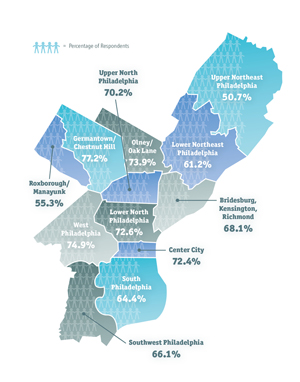How connected are you to your social network? When was the last time you picked up the phone to talk with a friend? Joined a softball team? Chatted with your neighbor who lives across the street? For years, sociologists have studied people’s connectedness to their communities, termed “social capital.” Social capital—usually defined as social networks, social participation, trust and reciprocity—is widely considered to influence health. The more researchers study and measure social capital, the more apparent it becomes that relationships and connections to one’s larger community can play a positive role in personal health. Since 2002, PHMC’s Household Health Survey has included several measures of community connectedness.
The social capital data from the 2008 Household Health Survey shows that most Southeastern Pennsylvania adults (87%) feel a sense of belonging in their neighborhoods. Half of the adults in the region (52%) participate in at least one club, organization or group in their neighborhoods, including parent teacher groups, religious groups, political organizations, and social and athletic clubs. Fifty-nine percent indicated that their neighbors have, at some point, worked together on a community project and well over three-quarters of adults in SEPA (81%) feel they can trust their neighbors.
The Trust Factor
Data show that an association between health and trust does exist; many adults who feel they can trust their neighbors also have better health. However, researchers are still exploring the correlation between the two. In SEPA, 84% percent of adults who feel their neighbors can be trusted also report being in excellent or good health, in contrast to 70% of those who do not feel they can trust their neighbors reporting that level of health.
- Older adults are more likely to trust their neighbors than younger adults (91% and 71%, respectively).
- Adults living below the Federal Poverty Level* in SEPA are less likely to report trusting their neighbors. Eighty-four percent of adults living above the Federal Poverty Line and 59% of adults living below it trust their neighbors.
- Adults living in Philadelphia are least likely to trust their neighbors (65%) compared with those in suburban SEPA counties (92% Montgomery, 91% Bucks, 89% Chester, 87% Delaware).

click on the thumbnail above to view a larger image
Working with Neighbors to Build Communities
The more connected you feel to your immediate neighborhood, the better your health and the better your community. More than half of adults in SEPA (57%) believe that their neighbors are willing to help each other, and even more have worked on projects together in their communities.
- African-American adults in SEPA were more likely than were white adults to say that their neighbors worked together on a project (71% and 57%, respectively).
- Philadelphia residents were more likely than residents of suburban counties to report that their neighbors worked together on a project in their community. Two-thirds of city residents (67%) indicated that their neighbors had done this, compared with 57% in Chester County, 55% in Delaware County, 54% in Montgomery County and 53% in Bucks County.
- Within Philadelphia, neighbors working together varied by neighborhood. Three-quarters of adults in the Germantown/Chestnut Hill and West Philadelphia sections of Philadelphia stated their neighbors had worked together on a project (77% and 75%, respectively), while in the Roxborough/Manayunk and Upper Northeast areas of the city just over half of adults reported that their neighbors worked together on a community project (55% and 51%, respectively).
A Feeling of Belonging and Well-Being
How comfortable and welcome you feel in your neighborhood could affect your health. Happily, most adults in SEPA—approximately 2,525,800 people or 87%—feel they belong in their neighborhood, and 82% of those same adults report being in excellent or good health. However, only 71% of adults who feel like they do not belong in their neighborhoods indicated the same health status.
- While adults of all ages expressed a sense of belonging in their neighborhoods, older adults were more likely to make this statement. Ninety-four percent of adults 75 and older said they felt they belonged in their neighborhoods, compared with 83% of 18 to 39 year olds.
- White adults were more likely than African-American adults to report that they felt they belonged in their neighborhoods (90% and 81%, respectively).
- Within Philadelphia, residents of the Roxborough/Manayunk and Center City Planning Analysis sections were most likely to indicate a sense of belonging (90% and 89%, respectively), while residents of Southwest Philadelphia, Upper North Philadelphia and Bridesburg/Kensington/Port Richmond were least likely to report a sense of belonging (76%, 77% and 78%, respectively).
With the growing recognition of the social determinants of health, social capital is an increasingly important concept in public health research. For more information on our social capital data and the linkages of social capital and health in our region, contact research associate Rose Malinowski-Weingartner at rosemw@phmc.org.
* Poverty level is defined as 100% of the Federal Poverty Level. Poverty level is calculated based on family size and household income. For example, a family of four with an annual income of $22,050 in 2009 was considered living in poverty.





